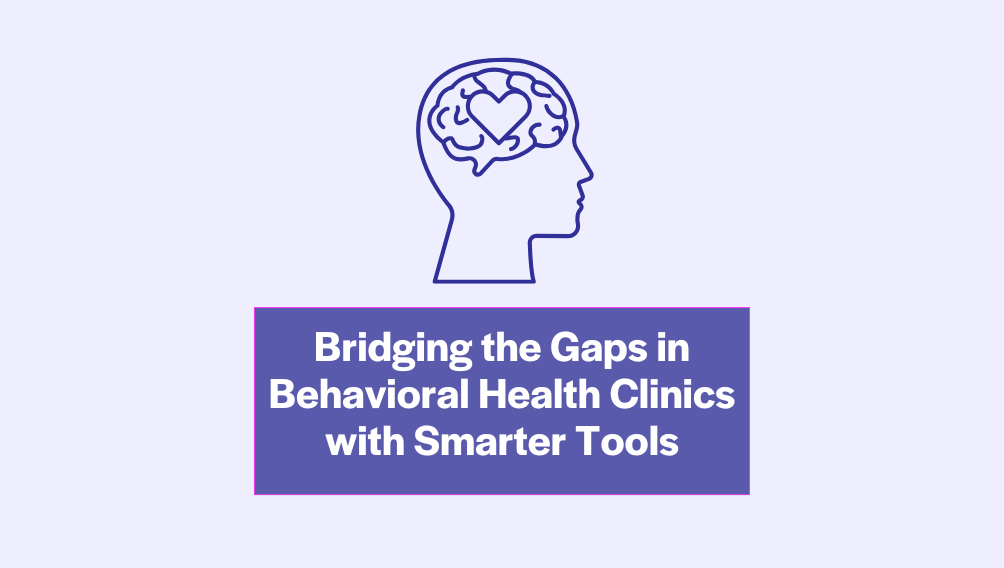Bridging the Gaps in Behavioral Health Clinics with Smarter Tools

As places where people find support for mental health, addiction, and trauma, behavioral health clinics are often hubs of hope. Yet behind the scenes, clinic administrators face a perfect storm of challenges: high no-show rates, stretched-thin staff, complex intake, coordination breakdowns, and sensitive communication hurdles. These issues don’t just weaken revenue – they disrupt care and burn out providers.
But with thoughtful use of technology, clinics can reduce those burdens, reframe workflows, and ultimately help patients better. This blog post explores the top pain points behavioral health leaders face and how targeted tools can make a real difference.
Challenge 1: Too Many Patients, Too Few Therapists
Behavioral health clinics often juggle growing demand against limited providers, especially when psychiatrists are in short supply. Waitlists stretch into weeks which leaves patients feeling anxious and staff overwhelmed.
“We have more demand than we can handle – patients wait weeks to see a psychiatrist, and we just don’t have enough providers.”
In this environment, every missed appointment or delayed consultation compounds the problem. And as pressure grows, staff burnout and turnover follow.
A better formula? Clinics that integrate waitlist tools with self-scheduling see shorter wait times. Patients can choose available slots which staff have programmed to ensure appropriate placement. This simple shift helps clinics manage capacity more efficiently.
Challenge 2: Burdens on Providers Fuel Burnout
Long hours, emotional fatigue, and constant retraining are real for many behavioral health clinics, especially those funded publicly. Waiting on paperwork, verifying eligibility, coordinating care, and dragging calls into evening hours wear providers down. When staff do everything from phone intake to no-show follow-ups, it’s unsustainable.
Tech can lift the load through:
- Automated outreach frees up staff bandwidth.
- Online intake forms reduce reception calls.
- Two-way secure messaging lets patients ask quick questions without tying up phone lines.
All of these add up to better care and more sustainable work for staff.
Challenge 3: Scheduling and Intake Are Manual Nightmares
For many clinics, intake means calling dozens of new patients to schedule, explain paperwork, send reminders, and follow up manually. That’s hours spent on logistics instead of healing.
“Scheduling and intake are a nightmare – there are so many phone calls, forms, and back-and-forth just to get someone in the door.”
Paper forms still get faxed, copied, lost. Incomplete intake leads to late cancellations and no-shows, compounding stress for everyone.
What if patients could do it themselves? Digital intake forms that are sent ahead of time let patients complete surveys and consent in their own time. Then, an automated, personalized reminder before the session confirms they’re ready. That eliminates much of the friction and anxiety for patients and cuts hours of administrative work.
Challenge 4: No‑Shows Block Treatment Progress
It’s a familiar story in behavioral health: a patient doesn’t show up, and the day’s schedule collapses. Admins and therapists scramble to fill gaps, often unsuccessfully. That disruption goes far beyond lost revenue:
- Patients lose therapeutic momentum, and missed sessions can slow or interrupt treatment progress.
Clinics build waiting lists, straining resources even more. - Therapists grow frustrated and burned out because they train for healing, not rescheduling.
The fix? Smart reminders and seamless rescheduling tools. Clinics that implement automated SMS and email reminders where patients can confirm or reschedule see dramatic drops in no-shows. And when cancellations do happen, clinics can offer those open slots to other patients via an automatic waitlist system, keeping the schedule moving.
Challenge 5: Privacy, Stigma & Tech Barriers
Behavioral health brings unique sensitivity. Between telehealth, email, and phone calls, patients worry about security and confidentiality. Many prefer low-tech options and could feel uncomfortable responding to automated messages.
“Many of our patients struggle with technology, are hesitant to engage, or are worried about privacy. It really makes communication tough.”
One FQHC clinic which includes behavioral health, however, found a middle ground: Spanish-language text reminders, simple scheduling links, and optional secure chat. As a result:
- Enrollment in texting increased by 20%
- Appointment cancellations dropped by 15%
- 82% response rate on outreach texts
That story shows that thoughtful, respectful communication, even done digitally, can build trust instead of breaking it.
Quick Wins You Can Try Right Now
- Send reminders that let patients confirm or reschedule. Two-way messaging means patients can respond directly, which will reduce no-shows and free staff from making follow-up calls.
- Streamline your intake process. Use online forms before the session. That ensures paperwork is done ahead of time and removes a source of patient anxiety.
- Use smart waitlists to reduce wait times. When appointments open up, make them available via text or self-scheduling links. It keeps care flowing smoothly.
With tools that support communication, coordination, and convenience that are used with care and respect, clinics can lighten the load, strengthen relationships, and bolster care continuity.
Patients deserve easier access and more privacy, and clinics deserve ease and sustainable workflows. With simple digital tools, that balance is within reach.
Want to see how your behavioral health practice could benefit from smarter workflows and more connected patient experiences? Schedule a personalized demo with the Luma Health team to explore how our platform can help you streamline operations, reduce no-shows, and support your patients every step of the way.